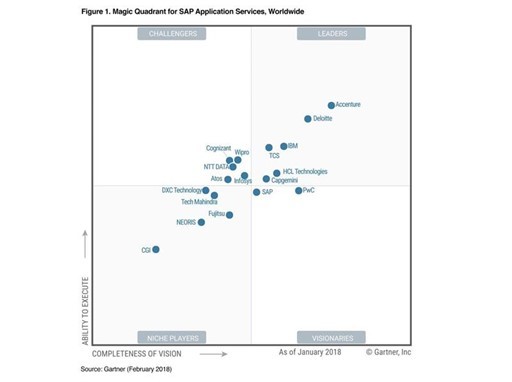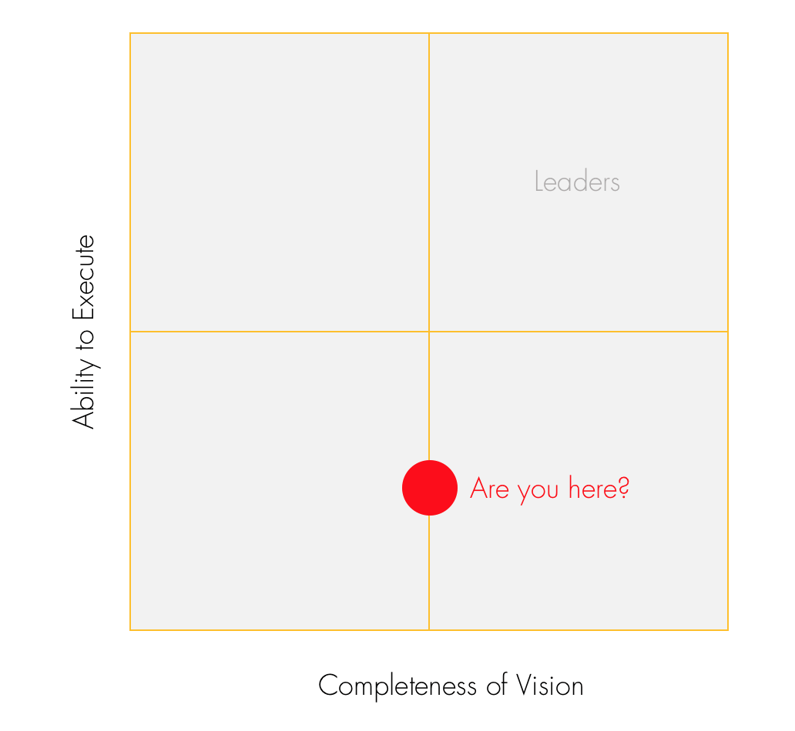
If you work in IT you’ll have heard of Gartner.
They’re one of a handful of Analyst firms who carry out research and publish papers that influence decision makers like CIOs.
They do other stuff too, but their core business involves selling subscriptions for their research notes and papers to business customers and vendors.
It's a Kind of Magic
One of Gartner’s most prominent, most frequently quoted and most eagerly awaited research notes is their Magic Quadrant series. Gartner chooses topic areas (e.g. SAP Systems Integrators or Cloud Hosting Providers) and carries out detailed research on the capabilities of the various vendors in each area.
Vendors are plotted on a 2x2 grid.
On the Horizontal Axis, they plot Completeness of Vision. This demonstrates how each vendor fares in terms of their thinking, roadmap, vision and market positioning.
Then, on the Vertical Axis, they plot Ability to Execute. This demonstrates how capable each vendor is in terms of delivering on what they say they can do.

Each square on the grid represents a placing on the Magic Quadrant. If you’re lucky enough to make the top-right Leaders Quadrant, you're made for life.
CIOs and their decision-making teams would be foolish not to invite the Leaders to bid on their next RFP. So you go straight to the top of the mailing list for tasty new RFPs.
Clearly, Gartner's double sided business model monetizes both the vendors to syndicate this powerful content as marketing material and business customers who subscribe to their research content.
It's bulletproof in concept, in execution and as a commercial model for Gartner.
What's more, people lap up the Magic Quadrant.
But it’s actually more Tragic than Magic.
To illustrate, let’s play out a ‘transformation’…
Transforming ACME Horse Food
ACME Horse Food needs to transform their sales and supply chain. The business is being overtaken by hungry competitors who have mobilized their supply chain so that customers who can now track horse food deliveries in real time.
Worst still, ACME is losing market share with the emergence of B2B eCommerce solutions eating away at their telesales on a month-by-month basis. They need to act and fast and get the business on a modern, stable platform.
ACME’s CIO Ed Shire has spoken to Gartner and reviewed their Magic Quadrants.
He believes that SAP is the way to go as they appear to be leaders in the relevant Magic Quadrants. He speaks to them and sees their solution in action. The sales pitch is good and the software seems a good fit for ACME's needs.
No need to look at other options - plenty of large businesses like ACME run SAP and although there are some stories of project failures, Ed’s confident that his team can manage the complexity
Next, Ed looks at the Systems Integrator Magic Quadrant.
He’ll invite Accenture, Capgemini and TCS to bid. The RFP process is tough and after 3-months and 3 very different 100-page bid documents, 2 presentations and some hard thinking, ACME contract with Capgemini to implement the solution.
Accenture make a late play to change his mind with a play to outsource Finance to their BPO centre in Bratislava as part of the transformation but Ed sticks with his decision. He needs to crack on if the business is going to survive and the board is already on his back.
Both SAP and Capgemini are Leaders. Complete Vision and Able to Execute.
Big green ticks in the boxes.
Ed can’t fail, right?
This is where the Tragedy kicks in.
What about ACME’s position on the Tragic Quadrant?
Sure, Ed and his exec team have a vision of sorts. They know what they need to do to catch up with their competitors.
OK, so their vision isn’t quite as well formed as it could be to dominate their market. The Accenture Finance BPO option had made him think - why shouldn’t we outsource some of our commodity business processes and focus on customer experience and supply chain?
Thinking about it, could we also outsource our supply chain to DHL too? But after that KFC incident, can't be associated with starving horses across the country. No, let’s leave our vision where it is for now.
The vision is fine for the next 2-3 years.
Small steps…
What about ACME’s ability to execute?
Hmmm.. We’ve never done an SAP project before.
Our legacy IT team will need to be re-skilled. And our data is in pretty bad shape at the moment. Plus, the merger with Neddy Feed in 2015 left a few fragments of non-standard business processes, duplicate products and 2 warehouses that could be consolidated down.
These things could hold us back a little. But they're addressable.
Are the business people we have available for the project up to the challenge? Can they run the business, transform the business and absorb SAP at the same time? They're bright people and aren't afraid of hard work though.
In fact, who is going to project manage it from our side? I need to be the sponsor and not get dragged into the detail. We’ll also need to look at hiring new people and ensure we track the costs. It’s an 8-month project and our commercials are finely balanced - a 1-month over-run blows our budget.
Plus, hosting - let's ask Gartner about that too.
The tragedy of the tragic quadrant is that even when businesses choose Software and Systems Integrators and Hosting partners from the Leader corner, they fail to place themselves on the Tragic Quadrant.
SAP failures are rarely down to the software. SAP is rock solid. OK, it’s not the prettiest or most user-friendly, which brings its own challenges. But it is proven and robust.
Similarly, SAP failures are rarely down to bad Systems Integrators. As a business, you choose your Systems Integrator. You write the RFP, You select them and you negotiate the commercials. You then have RAID meetings and SteerCo’s where you can call them out from Day 1 to Day 365 if you want to.
No, SAP failures are generally down to businesses who have a 50% complete vision and 25% ability to Execute.

They’ve never done an SAP transformation before. They don’t have the experience to do the business-side things that matter. They get trampled on by Systems Integrators and rushed into making bad decisions. They fail to do the important things well. And then they point fingers at the Leaders they choose to help them.
This is why Resulting provides Business-Side Consultancy - to improve the business’s ability to execute - by adding a dollop of deep SAP experience with a business side conscience. Working in the business with their interests at heart.
Doing it with them and not to them.
And it’s why we developed our Preflight Check - to educate SAP customers on the things they need to do to improve their chances of success by addressing 70 of the most common root causes of SAP project failure.
To push them to be leaders on their own Magic Quadrant.
If you run SAP and want to be a Leader in your Magic Quadrant like the vendors you’ve selected, take a look at our Preflight Check.
Or ACME will go out of business and these ponies will starve...
Download "Fifty shades of blue: the secrets to taking control of your S/4HANA journey" for everything you need to know about S/4HANA migration.
.png?width=290&name=67ea7008fb82616d688a6cfe-HeadshotPro%20(2).png)











